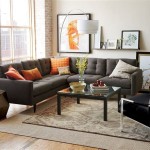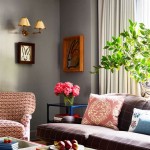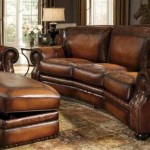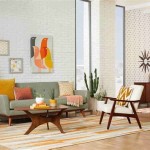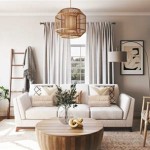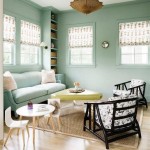Modern Living Room Rug Ideas: A Guide to Defining Your Space
The living room serves as the central gathering space in many homes, a place for relaxation, entertainment, and connection. A well-chosen rug can significantly enhance the aesthetic appeal and functionality of this vital area. In the context of modern design, rugs are not merely floor coverings; they are essential decorative elements that define the room's style, add warmth, and provide visual anchor. This article explores various modern living room rug ideas, considering factors such as size, material, pattern, and color, to assist in creating a harmonious and stylish living space.
Understanding Rug Size and Placement
Selecting the appropriate rug size is paramount in achieving a balanced and visually pleasing living room. A rug that is too small can make the room feel disjointed, while one that is too large can overwhelm the space. The key is to consider the furniture arrangement and the overall dimensions of the room.
All Furniture On: This approach is suitable for larger living rooms. All the furniture pieces, including the sofa, chairs, and coffee table, are placed entirely on the rug. This creates a unified and luxurious feel, effectively defining the seating area as a single, cohesive unit. When adopting this style, ensure a border of bare floor remains around the perimeter of the rug, typically 12-18 inches, to prevent the room from feeling cramped.
Front Legs On: A popular and versatile option, this placement involves positioning the front legs of the sofa and chairs on the rug, while the back legs remain on the bare floor. This method grounds the furniture grouping without fully committing to a large rug. It works well in various room sizes and creates a defined but airy feel. The rug should extend at least 12 inches beyond the front legs of the furniture to avoid a visually awkward overlap.
Floating Rug: Ideal for smaller living rooms or when highlighting existing flooring, the floating rug placement involves positioning the rug in the center of the seating area, with all furniture legs completely off the rug. This approach allows the rug to serve as a decorative focal point without dictating the entire furniture arrangement. The size of the rug should be proportionate to the coffee table and the overall seating area it's anchoring.
Beyond these general guidelines, the specific dimensions of the rug should be tailored to the room's unique layout and the desired aesthetic. Consider using painter's tape to map out different rug sizes and placements before making a purchase. This visual aid can prevent costly mistakes and ensure the rug complements the existing decor.
Exploring Materials and Textures
The material and texture of a rug significantly impact its appearance, durability, and feel underfoot. Selecting the right material is crucial to achieving the desired aesthetic and functionality for the living room.
Wool: Wool rugs are renowned for their durability, softness, and natural stain resistance. They are a popular choice for high-traffic areas like the living room. Wool fibers can withstand years of use while maintaining their appearance. They also offer excellent insulation, adding warmth and comfort to the space. Wool rugs come in a wide variety of styles and price points, making them a versatile option for diverse design preferences. However, they can be more expensive than synthetic alternatives and may require professional cleaning.
Synthetic Fibers (Polypropylene, Polyester, Acrylic): Synthetic rugs are a budget-friendly and low-maintenance alternative to wool. They are typically stain-resistant, easy to clean, and available in a wide range of colors and patterns. Polypropylene, polyester, and acrylic are common synthetic fibers used in rug construction. While not as durable or luxurious as wool, synthetic rugs are a practical choice for busy households or those seeking a cost-effective option. They are also less prone to shedding and fading, making them suitable for sunny living rooms.
Natural Fibers (Jute, Sisal, Cotton): Natural fiber rugs offer a textured and organic look. Jute and sisal rugs are durable and add a rustic touch. Cotton rugs are soft and comfortable but may be less durable than other options. These rugs are typically more affordable than wool and can add a casual, relaxed feel to the living room. However, they may be more susceptible to staining and moisture damage, requiring careful maintenance and placement. They are generally not recommended for areas prone to spills or high humidity.
Blended Materials: Rugs crafted from a blend of different materials, such as wool and silk, or synthetic and natural fibers, offer a combination of benefits. These blends can enhance durability, add visual interest, and create unique textures. For instance, a wool-silk blend can provide the durability of wool with the added sheen and softness of silk. Similarly, a blend of polypropylene and cotton can offer the stain resistance of synthetic fibers with the softness of natural cotton.
The texture of the rug also plays a crucial role in the overall aesthetic. Shag rugs offer a plush and cozy feel, while flatweave rugs provide a sleek and modern look. Consider the texture of the rug in relation to the other textiles in the living room, such as the sofa upholstery and throw pillows, to create a harmonious and inviting space.
Selecting Patterns and Colors
The pattern and color of a rug can dramatically influence the overall ambiance of the living room. A bold pattern can serve as a focal point, while a subtle color palette can create a calming and cohesive environment. Selecting the right pattern and color requires careful consideration of the existing decor and the desired mood.
Neutral Tones: Neutral rugs, such as those in shades of gray, beige, cream, or white, offer a versatile and timeless option for the modern living room. They provide a neutral backdrop that allows other elements in the room to shine, such as colorful artwork or bold furniture pieces. Neutral rugs can also help to create a sense of spaciousness and light, particularly in smaller living rooms. They are well-suited for minimalist or Scandinavian-inspired designs. The key is to choose neutral tones that complement the existing wall color and furniture upholstery.
Geometric Patterns: Geometric patterns, such as stripes, chevrons, or abstract shapes, can add a modern and dynamic touch to the living room. They can create a sense of visual interest and movement, particularly in rooms with solid-colored furniture. Geometric rugs are available in a wide range of colors and scales, allowing for customization to suit diverse design preferences. Consider the scale of the pattern in relation to the size of the room; larger patterns can overwhelm smaller spaces, while smaller patterns may get lost in larger rooms.
Abstract Designs: Abstract rugs feature free-flowing shapes, organic lines, and unconventional color combinations. They offer a more artistic and expressive alternative to traditional patterns, adding a unique and personalized touch to the living room. Abstract rugs can serve as a conversation starter and create a focal point in the room. They are particularly well-suited for contemporary or eclectic designs. When selecting an abstract rug, consider the color palette and ensure it coordinates with the existing decor to maintain a sense of balance.
Color Considerations: The color of the rug should complement the overall color scheme of the living room. Consider the wall color, furniture upholstery, and accent colors when making a selection. A monochromatic color scheme, where the rug features different shades of the same color, can create a cohesive and calming environment. Alternatively, a contrasting color scheme, where the rug features colors that are opposite each other on the color wheel, can add a sense of energy and visual interest. Remember that lighter colors tend to make a room appear larger and brighter, while darker colors can add warmth and intimacy.
Furthermore, consider the texture alongside the color and pattern. A high-pile shag rug in a bold color may be too overwhelming for a small space, while a flatweave rug with a subtle geometric pattern in neutral tones may be more appropriate. The key is to find a balance that complements the existing decor and creates the desired ambiance.
Ultimately, the selection of a modern living room rug involves a thoughtful consideration of size, material, and design. By carefully evaluating these factors and considering the room's existing aesthetic, homeowners can choose a rug that enhances the beauty, comfort, and functionality of their living space.

New Rug Ideas For My Living Room A Stroll Thru Life

Modern Classic Rug Ideas For The Living Room

Geometric Modern Rug Placement Ideas For Living Room Bedroom R Paintingforhome

11 Modern Rug Ideas To Revive Your Living Room Nb

51 Living Room Rug Ideas Stylish Area Rugs For Rooms

Modern Living Room Rug Placement Ideas Geometric Carpets For Office Bedroom Area Rugs Under Dining Table

51 Living Room Rug Ideas Stylish Area Rugs For Rooms

Embrace Natural 24 Rustic Living Room Decor Ideas Rugs Direct

5 Rug Ideas For Living Room Decor Carpet Call

Modern Carpet Ideas The Best Rugs For Family Events

